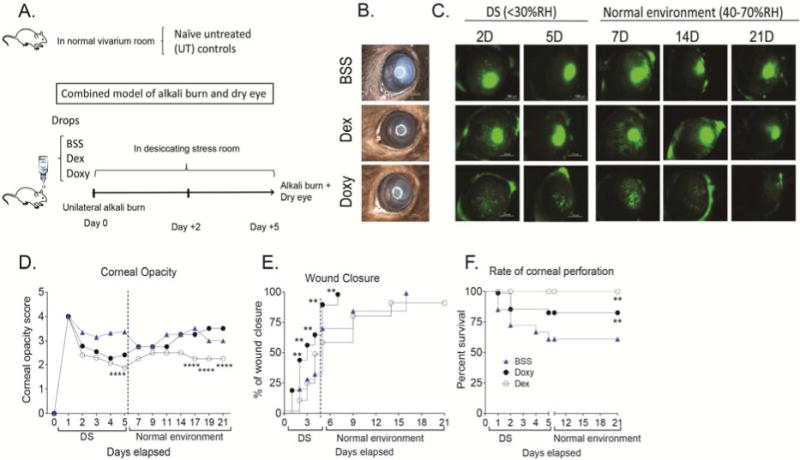Figure 1.

Anti-inflammatory therapy improves clinical parameters in a combined model (CM) of alkali burn and dry eye.
A. Schematic of experimental design of the combined model of alkali burn and dry eye. A unilateral alkali burn (AB) was created on the right cornea as described in materials and methods. Mice were then subjected to desiccating stress and topically treated with either balanced salt solution (BSS), dexamethasone (Dex) or doxycycline (Doxy). Control mice were kept in a normal vivarium room (untreated animals, UT).
B. Bright field digital images of alkali burn and dry eye combined model treated with either balanced salt solution (BSS), dexamethasone (Dex) or doxycycline (Doxy) 5 days (5D) post-injury. Scale bar=1000 μm.
C. Representative digital images of corneas post-injury stained with 0.1% sodium fluorescein after creation of alkali burn lesion and induction of dry eye topically treated with BSS, Dex or Doxy for 5 days and then topically treated for 16 days in normal environment. Scale bar=1000 μm.
D. Corneal opacity score in CM corneas topically treated with BSS, Dex, or Doxy. Asterisks show significant p value compared to vehicle.
E. Survival rate of wound closure in CM corneas topically treated with BSS, Dex, or Doxy.
F. Rate of ocular perforation in eyes subjected to CM topically treated with BSS, Dex, or Doxy.
*p<.05, **p<.01; ***p<.001, ****p<.0001.
BSS=corneas subjected to alkali burn and dry eye and treated topically with balanced salt solution, Dex=corneas subjected to alkali burn and dry eye and treated topically with dexamethasone, Doxy=corneas subjected to alkali burn and dry eye and treated topically with doxycycline, D=days.
